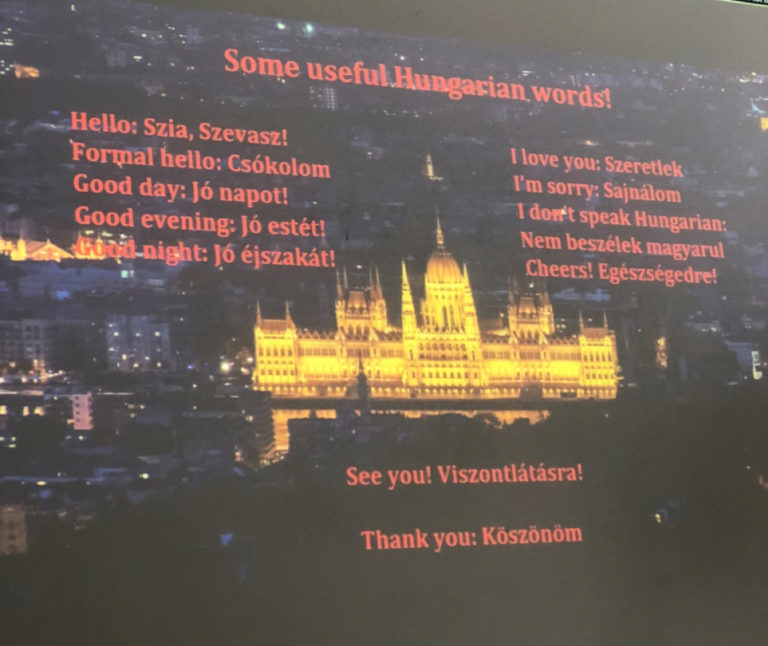Budapest Language, a captivating tapestry of linguistic influences, unveils the rich cultural heritage and vibrant multilingualism of Hungary’s capital. From its historical roots to its present-day landscape, the city’s language reflects a fascinating interplay of diverse cultures, shaping the unique identity of Budapest.
The current language landscape of Budapest presents a kaleidoscope of tongues, with Hungarian as the dominant language. Yet, amidst this linguistic tapestry, other languages such as English, German, and Russian weave their threads, reflecting the city’s international connections and cosmopolitan atmosphere.
Historical Evolution of Budapest’s Language
The linguistic history of Budapest is a complex and fascinating one, reflecting the city’s rich and diverse cultural heritage. The city’s language has been shaped by a variety of influences, including Slavic, Germanic, and Hungarian, and has evolved over time to reflect the changing political and social landscape of the region.
Slavic Influence
The earliest inhabitants of the Budapest area were Slavic peoples, and their language, Slavic, had a significant influence on the development of the city’s language. Slavic words can still be found in the Budapest dialect today, particularly in the vocabulary related to everyday life and the natural world.
Germanic Influence
In the 10th century, Budapest was conquered by the Magyars, a nomadic people from the steppes of Central Asia. The Magyars brought their own language, Hungarian, to Budapest, and it soon became the dominant language of the city. However, Hungarian also borrowed many words from German, particularly in the areas of government, law, and commerce.
Hungarian Influence
Over time, Hungarian became the dominant language of Budapest, and it has continued to evolve and change to reflect the city’s changing political and social landscape. In the 19th century, Budapest became a major center of culture and learning, and the city’s language was enriched by the influx of new words and ideas from around the world.
Today
Today, the Budapest dialect is a vibrant and dynamic language, spoken by over 2 million people in the city and its surrounding region. It is a unique blend of Slavic, Germanic, and Hungarian influences, and it continues to evolve to reflect the city’s changing cultural and social landscape.
Current Language Landscape of Budapest

Budapest, as the capital of Hungary, is a linguistically diverse city. The language landscape of Budapest reflects the city’s rich history and its role as a cultural and economic hub in Central Europe.
Hungarian is the official language of Budapest and is spoken by the vast majority of the city’s population. However, due to Budapest’s historical and geographical position, several other languages are also spoken in the city.
Distribution and Usage of Languages
The distribution and usage of different languages in Budapest vary depending on the domain. Hungarian is the dominant language in most domains, including education, government, and media.
- Education:Hungarian is the primary language of instruction in schools and universities in Budapest. However, there are also schools that offer instruction in other languages, such as English, German, and French.
- Government:Hungarian is the official language of the Hungarian government and is used in all official government documents and proceedings. However, other languages, such as English and German, are also used in international relations and diplomacy.
- Media:Hungarian is the dominant language of the media in Budapest. However, there are also media outlets that broadcast in other languages, such as English, German, and French.
Sociolinguistic Factors Influencing Language Use in Budapest
The language landscape of Budapest is shaped by a complex interplay of social and cultural factors, including ethnicity, migration, and social class. These factors influence language choice and usage in various ways.
Ethnicity
Budapest’s diverse ethnic composition has contributed to the city’s linguistic diversity. The Hungarian population forms the majority, but there are significant minority groups, including Roma, Germans, Slovaks, and Serbs. Each ethnic group often maintains its own language and cultural practices, leading to a multilingual environment in certain neighborhoods.
Migration
Budapest has been a destination for migrants throughout its history. In recent decades, the city has witnessed an influx of immigrants from neighboring countries, as well as from further afield. These migrants bring their own languages and cultural influences, further enriching the linguistic tapestry of Budapest.
Social Class
Social class also plays a role in language use in Budapest. Historically, the upper classes have tended to be more multilingual, often speaking German, French, or English as a second or third language. This pattern persists to some extent today, with higher levels of education and income being associated with greater language proficiency.
Language Policy and Planning in Budapest
Budapest has a long history of language policy and planning, with the aim of promoting linguistic diversity and fostering social cohesion. The city’s language policies have evolved over time, reflecting changing political and social circumstances.
One of the most significant language policy initiatives in Budapest was the adoption of the Budapest Declaration on Linguistic Diversity in 2008. This declaration committed the city to promoting linguistic diversity and protecting the rights of all language communities. The declaration also established a number of specific goals, including increasing the use of minority languages in public life, providing language support services for migrants and refugees, and promoting intercultural dialogue.
Effectiveness of Language Policies
The effectiveness of Budapest’s language policies in promoting linguistic diversity and fostering social cohesion is difficult to assess. There is some evidence that the policies have been successful in increasing the use of minority languages in public life. For example, the number of schools offering instruction in minority languages has increased in recent years.
However, there is also evidence that the policies have not been fully effective in addressing the challenges faced by minority language communities. For example, there are still relatively few opportunities for people to use minority languages in the workplace or in public services.
Despite the challenges, Budapest’s language policies represent an important commitment to promoting linguistic diversity and fostering social cohesion. The city’s policies are based on the recognition that linguistic diversity is a valuable asset that should be celebrated and protected.
Language Education in Budapest

Budapest’s language education system offers a diverse range of opportunities for language learning, catering to students of all ages and levels. The city’s multilingual environment provides a unique context for language teaching and learning, presenting both challenges and opportunities.The education system in Budapest includes primary, secondary, and tertiary levels, with language education playing a significant role at each stage.
In primary schools, students begin learning a foreign language, typically English or German, from an early age. In secondary schools, students continue their language studies and may choose to add additional languages to their repertoire. At the tertiary level, universities and colleges offer a wide range of language courses, including those in less commonly taught languages.One
of the challenges in teaching and learning languages in Budapest is the city’s multilingualism. While this provides students with exposure to different languages and cultures, it can also lead to interference and confusion, especially among younger learners. To address this challenge, language educators in Budapest employ a variety of teaching methods and strategies that promote language acquisition while minimizing interference.Another
challenge is the need to adapt language teaching to the specific needs of Budapest’s diverse student population. This includes students from different linguistic backgrounds, as well as students with special needs. To meet these needs, language educators in Budapest use differentiated instruction and provide support services to ensure that all students have the opportunity to succeed in their language learning.Despite
the challenges, the multilingual environment of Budapest also presents opportunities for language teaching and learning. The city’s international community and the presence of numerous language schools and cultural institutions provide students with ample opportunities to practice their language skills outside the classroom.
Additionally, the city’s rich cultural heritage and its proximity to other European countries make it an ideal destination for language immersion programs.Overall, the language education system in Budapest is well-equipped to meet the needs of its diverse student population. The city’s multilingual environment provides both challenges and opportunities for language teaching and learning, and language educators in Budapest are committed to providing students with the skills and knowledge they need to succeed in a globalized world.
Challenges in Language Teaching and Learning in Budapest, Budapest language
* Multilingualism can lead to interference and confusion among learners.
- The diverse student population requires differentiated instruction and support services.
- The need to adapt language teaching to the specific needs of Budapest’s international community.
Opportunities in Language Teaching and Learning in Budapest
* The multilingual environment provides ample opportunities for language practice outside the classroom.
- The city’s international community and cultural institutions offer resources for language immersion.
- Budapest’s proximity to other European countries makes it an ideal destination for language immersion programs.
The Role of Language in Budapest’s Cultural Identity: Budapest Language
Language plays a pivotal role in shaping and reflecting the unique cultural identity of Budapest. As the city’s primary mode of communication, it serves as a vehicle for transmitting cultural values, traditions, and beliefs. The rich tapestry of Budapest’s language encapsulates its diverse history, vibrant present, and aspirations for the future.
Preserving and promoting Budapest’s unique cultural heritage through language is of paramount importance. The city’s rich literary tradition, exemplified by renowned writers such as Sándor Márai and Péter Esterházy, has significantly contributed to Hungarian literature and global cultural discourse. Moreover, the preservation of traditional dialects and expressions ensures the continuity of Budapest’s linguistic heritage.
Language as a Symbol of Cultural Identity
Budapest’s language serves as a powerful symbol of its cultural identity. The Hungarian language, with its unique grammar and vocabulary, distinguishes Budapest from neighboring regions and fosters a sense of national pride and unity among its citizens. The city’s vibrant street life, filled with conversations in Hungarian, reflects the close connection between language and everyday cultural practices.
Language in Cultural Institutions
Cultural institutions in Budapest play a crucial role in promoting and preserving the city’s language. Museums, theaters, and libraries showcase Budapest’s rich literary and linguistic heritage through exhibitions, performances, and educational programs. These institutions provide a platform for Hungarians and visitors alike to engage with the city’s unique linguistic landscape.
Language in Education
Education plays a vital role in fostering language proficiency and preserving Budapest’s cultural identity. Schools and universities in the city offer a comprehensive curriculum that emphasizes Hungarian language and literature. This ensures that future generations of Budapesters have a strong foundation in their native language and a deep appreciation for its cultural significance.
End of Discussion

Budapest’s language is not merely a means of communication but a vibrant expression of its cultural identity. It is a testament to the city’s resilience, its ability to absorb and blend diverse linguistic influences, and its unwavering commitment to linguistic diversity.
As Budapest continues to evolve, so too will its language, reflecting the ever-changing tapestry of its people and their stories.
FAQs
What is the official language of Budapest?
Hungarian is the official language of Budapest.
What other languages are commonly spoken in Budapest?
English, German, and Russian are among the other commonly spoken languages in Budapest.
What factors have influenced the development of Budapest’s language?
Budapest’s language has been influenced by various factors, including its geographical location, historical events, and cultural exchanges.